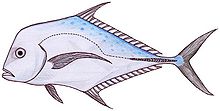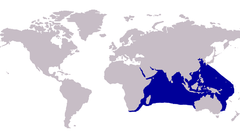- Indian threadfish
-
Indian threadfish 
Scientific classification Kingdom: Animalia Phylum: Chordata Class: Actinopterygii Order: Perciformes Suborder: Percoidei Superfamily: Percoidea Family: Carangidae Genus: Alectis Species: A. indicus Binomial name Alectis indicus
(Rüppell, 1830)Approximate distribution of the Indian threadfish Synonyms - Scyris indicus (Rüppell, 1830)
- Alectis indica (Rüppell, 1830)
- Seriolichthys indicus (Rüppell, 1830)
- Hynnis insanus (Valenciennes, 1862)
- Caranx gallus (Klunzinger, 1879)
- Hynnis momsa (Herre, 1927)
The Indian threadfish, Alectis indicus, (also known as the Indian threadfin, diamond trevally, mirror fish and plumed trevally) is a large species of coastal marine fish of the jack family, Carangidae. The species is widespread in the waters of the tropical Indo-West Pacific Ocean, ranging from east Africa to India, Asia, Indonesia and Australia. Adult fish tend to inhabit coastal waters over reefs down to 100 m in depth, while juveniles inhabit a variety of environments including estuaries and seagrass beds. The Indian threadfish is similar to the other two species in the genus Alectis, with a slight concavity in the profile of the head the most obvious distinguishing feature. It is a large species, growing to 165 cm and 25 kg in weight. The species is carnivorous, consuming fishes, cephalopods and crustaceans. The Indian threadfin is of minor commercial importance, and has been the subject of aquaculture in Singapore.
Contents
Taxonomy and naming
The Indian threadfish is one of three members of the diamond trevally genus Alectis, which itself is one of 33 genera encapsulated in the jack family, Carangidae. The Carangidae are perciform fishes in the suborder Percoidei.[1]
The species was first recognized and scientifically described by the German naturalist Eduard Rüppell in 1830 under the name Scyris indicus, with the type specimen collected from the Red Sea.[2] After Rüppell's designation, a number of other naturalists unknowingly re-described the species, with the names Hynnis insanus, Caranx gallus and Hynnis momsa applied to the species by the various authors. Rüppell's original classification was also revised; the fish was first placed in Seriolichthys, and finally in the senior genus Alectis by Ogilby in 1913. The species' name has occasionally been misspelled as Alectis indica in the literature.[3] All names except A. indicus are considered invalid under the ICZN naming rules and have been discarded.
The common name of the species, 'Indian threadfish' or 'Indian threadfin' refers to its distribution which includes Indian waters, and the characteristic elongated dorsal fins in juveniles. Other common names, such as mirror fish and diamond trevally, describe other aspects of the species' appearance.[2]
Description
The Indian threadfish has the typical body structure of a large jack, with a distinctly angular, strongly compressed body. The major identifying feature of the species is its head profile, having a slight concavity near the eyes which distinguishes it from its close relatives in the genus Alectis. The dorsal profile of the fish is more curved than the ventral profile, and the body is deepest between the origins of the soft dorsal and soft anal fins.[4] The first section of the dorsal fin consists of 5 to 7 visible spines, with the second section having one spine and 18 or 19 soft rays. The anal fin has two spines followed by a single spine and 15 or 16 soft rays. The pectoral fin is long and curved, extending beyond the junction of the straight and curved sections of the lateral line. The body appears to be scaleless, but on closer inspection has minute, deeply embedded scales. The lateral line is strongly curved anteriorly, with a section of 6 to 11 scutes toward the tail. Juveniles have long, filamentous trailing anal and dorsal fin spines, much like those of Alectis ciliaris.[3] The species is known to grow to 165 cm and 25 kg.[5]
The body of adults is a silvery blue-green colour above, being darkest on the head and silver below. The upper operculum has a small diffuse dark spot. The long filamentous soft dorsal and anal fins as well as the pelvic fin are a dark blue to black colour, while the others are pale green to hyaline in appearance. Juveniles have 5 to 7 broad dark vertical cross bands through their body.[4]
Distribution and habitat
The Indian threadfish inhabits the tropical regions of the Indian and Western Pacific Oceans, ranging from Madagascar, east Africa and the Red Sea to India, China, South East Asia, north to Japan and south to Indonesia and northern Australia.[3] The eastern most report is that of a specimen taken off French Polynesia in the Pacific.[5]
The species is generally an inhabitant of coastal waters from depths of 20 m to 100 m, although the juveniles may be pelagic, riding ocean currents. In some years currents bring the juveniles as far south as Sydney, Australia where they inhabit of estuaries in the summer, before dying off in the cold winter. The African pompano shows a similar pattern in Australian waters. The juveniles are also known to inhabit estuaries in other regions (including South Africa)[6] as well as seagrass beds.[7] Adults generally inhabit areas of reef below 20 m.[8]
Biology
The Indian threadfish is a predatory fish, consuming of a wide range of fishes, small squids, jellyfish and crustaceans. As with A. ciliaris, the trailing fins of juveniles are thought to resemble jellyfish medusae, causing predators to avoid the young fish. Relatively little is known about reproduction in the species, although observations made in Indonesia show spawning occurs in pairs at daytime between ebbing and flooding tides. The spawning area in this instance was a shoal of 35–45 m, located in a deeper channel between two islands.[9]
Relationship to humans
The Indian threadfish is a commercial fish of minor importance throughout its range, often forming part of artisanal fishery catches. Beach seines and hook-and-line methods are the predominant methods of capture.[3] Archaeological evidence has shown that the species has long been a resource for humans, with prehistoric and more modern sites in the United Arab Emirates yielding the preserved remains of this species, as well as a number of other carangids.[10] The species is commercially farmed in small numbers in Singapore using aquaculture techniques. These farmed fish generally sell for between 7 and 11 US dollars per kg, as high or higher than other jacks farmed in the country.[11] They are also considered quality gamefish, although are not purposely targeted by anglers, and are often taken as bycatch.
Juveniles are moderately popular aquarium fishes, but require fairly large tanks and peaceful neighbours.[12]
References
- ^ "Alectis indicus". Integrated Taxonomic Information System. http://www.itis.gov/servlet/SingleRpt/SingleRpt?search_topic=TSN&search_value=168604. Retrieved 21 October 2007.
- ^ a b Hosese, D.F.; Bray, D.J., Paxton, J.R. and Alen, G.R. (2007). Zoological Catalogue of Australia Vol. 35 (2) Fishes. Sydney: CSIRO. pp. 1150. ISBN 978-0-643-09334-8.
- ^ a b c d Carpenter, Kent E.; Volker H. Niem (eds.) (2001). FAO species identification guide for fishery purposes. The living marine resources of the Western Central Pacific. Volume 5. Bony fishes part 3 (Menidae to Pomacentridae). Rome: FAO. pp. 2684. ISBN 92-5-104587-9. ftp://ftp.fao.org/docrep/fao/009/y4160e/y4160e00.pdf.
- ^ a b Gunn, John S. (1990). "A revision of selected genera of the family Carangidae (Pisces) from Australian waters". Records of the Australian Museum Supplement 12: 1–78.
- ^ a b Froese, Rainer, and Daniel Pauly, eds. (2007). "Alectis indicus" in FishBase. October 2007 version.
- ^ Blaber, S.J.M.; D.P. Cyrus (1983). "The biology of Carangidae (Teleostei) in Natal estuaries". Journal of Fish Biology (Blackwell Synergy) 173-188 (22): 2. doi:10.1111/j.1095-8649.1983.tb04738.x.
- ^ Gell, Fiona R.; Mark W. Whittington (2002). "Diversity of fishes in seagrass beds in the Quirimba Archipelago, northern Mozambique". Marine & Freshwater Research (CSIRO) 53 (2): 115–121. doi:10.1071/MF01125.
- ^ Hutchins, B.; Swainston, R. (1986). Sea Fishes of Southern Australia: Complete Field Guide for Anglers and Divers. Melbourne: Swainston Publishing. pp. 1–187. ISBN 1-86252-661-3.
- ^ Westernhagen, H. Von (1974). "Observations on the natural spawning of Alectis indicus (Rüppell) and Caranx ignobilis (Forsk.) (Carangidae)". Journal of Fish Biology (Blackwell Synergy) 6 (4): 513–516. doi:10.1111/j.1095-8649.1974.tb04567.x.
- ^ Potts, D.T. (1997). Before the Emirates: an Archaeological and Historical Account of Developments in the Region c. 5000 BC to 676 AD in Perspectives on the United Arab Emirates. pp. pp 28–69. http://uaeinteract.com/uaeint_misc/pdf/perspectives/02.pdf.
- ^ Chou, R.; H.B. Lee (1997). "Commercial marine fish farming in Singapore". Aquaculture Research (Blackwell Synergy) 28 (10): 767–776. doi:10.1046/j.1365-2109.1997.00941.x.
- ^ Pet education. "Indian threadfin". Fish. Foster & Smith, Inc. http://www.peteducation.com/article.cfm?cls=16&cat=1883&articleid=1944. Retrieved 2007-10-23.
External links
Categories:
Wikimedia Foundation. 2010.

